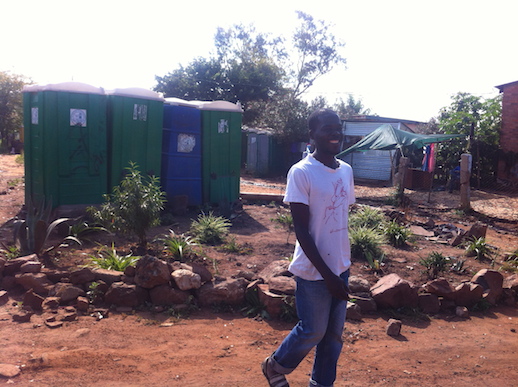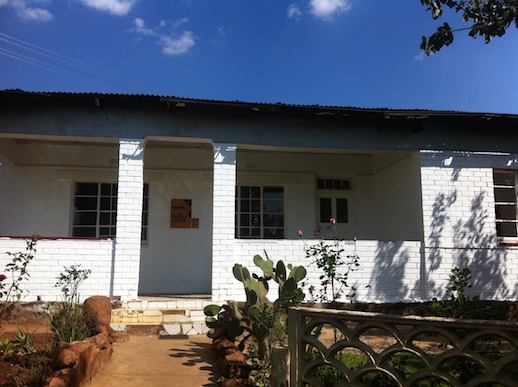Words and pictures: Emma Warren
Bafana Nkosi is Kliptown’s only bird tour guide. It’s a hot April afternoon and he’s sauntering down an ochre track to the wetlands behind Soweto’s oldest informal settlement with locally-ubiquitous sandals made from white taxi tyres on his feet. He’s a charming and disarming host, full of wry asides and rich local knowledge.
“Most of the life down here is in the reeds,” he says, standing calmly by the Klipspruit river which demarcates one edge of this township’s square kilometer. “We have two types of Ibis here, the Hadida Ibis and the African Sacred Ibis. We have Red Eye Doves and Long-Tailed Widowbirds. You’ll find a male with five wives, like their husbands have passed on. Other birds I’ve identified in Kliptown are the Black-Collared Parrot, the Grey Lourie which is known as the ‘Go-Away Bird’ and the Grey Heron.”
It’s a stupendously tough environment for nature, where yellow trains gallop past with train-surfing youths up top and where, unlike most of Soweto, 45,000 people live without electricity, running water or proper sanitation. Bafana pauses his litany of bird identification and looks at the coppery water that flows deep between the red and rocky banks. “The water is dead, polluted, so most bird life that lives in the water – you don’t find it here.”
The pollution might have deleted the fish and river life but it hasn’t stopped the birds, and Bafana has been meticulously recording Kliptown’s avian life since 2005, when he was trained by BirdLife South Africa as part of a project to address the country’s chronic unemployment. “When I grew up I never had an interest about birds. I just thought they were flying animals. When I found out they were different, with different names, that’s what captured me. I fell in love.”
He went to Bird Life’s Wakkerstroom centre for a month where he was trained in identifying birds and arranging tours. He returned to Kliptown and began recording local birdlife – although since the project ended, he’s been keeping his records in isolation, carefully noting down each Laughing Dove or Red Bishop and evangelising to his fellow Kliptonians about the delights of birding.
“I’m training young kids and my friends, although we don’t have enough resources. We share my field guide. I want to make a collection of binoculars so that when I take people I don’t have the crisis of having to use one pair. When we’re in the field it’ll be too late for me to give you the binoculars because the chances are the bird would have flown.”
There are official tours in nearby Thokoza Park, and there’s a healthily nascent tourism sector in wider Soweto, which has a population of 1.5m. Daytrippers come to Vilakazi Street to eat, drink and see Mandela’s house; young tourists come to the very cool Bicycle Tours at the Soweto Backpackers; and over 100,000 people visit the heartbreaking Hector Pieterson Museum each year. Soweto has one of South African’s biggest shopping malls, a new theatre, a multiplex cinema and some great clubs including the Sunday night shebeen at Panyaza 707, but that’s all on the other side of the tracks. Right now, Bafana is a tour guide without tourists. He remains upbeat: “In the future I shall have recruited a whole lot of people. I am not going to be the only guy. There will be a lot of us… People are part of nature, we are one. We need to understand each other for us to live together.”
Back in the township proper there’s a rubbish tip with a portaloo perched at an unlikely angle just over the top. Outsized chickens and a rooster peck about on this hillock of uncollected plastic. Just behind, on the opposite river bank are two Hadida Ibis, standing stock-still like something out of a parallel universe Attenborough documentary. Bafana looks across the water. “The birds stay over there and they never come into the township. Why would they? If I could make something happen, and people would listen to me, I would remove people from the wetland and let the wetland breathe.”
The dead river, the triangular piles of plastic rubbish, and the lack of habitat are compounded by other, more human problems. “There are myths around birds,” he says. “People think that when they see an owl, someone is bewitching them. It means that we don’t have many of the owls. Once it has been seen, people will go out on a hunting spree. I try and tell people many times that the owls are only here because they eat rats, but they won’t listen.”
Bafana is more than just a birder. He’s a community activist trying to secure bursaries for local kids so they can continue with their schooling, and a gardener who transformed the rubbish tip outside his house into an attractive plot. He’s also a poet, part of the vibrant Kliptown art collective centered around the Post 77 Gallery, which is currently hosting an exhibition of Martha Cooper’s work.
“I don’t write about the birds but I write on nature, about how people have abandoned it. How many trees have you seen since you came to Kliptown? It’s not like the suburbs where in a single household they have more than ten trees. Trees and grass and plants have made space for human settlement. It has made people to forget that nature exists.”
The sun is making the slow shift out of the hottest angle and the afternoon is grinding on. There’s an orchid growing out of a small garden someone has created by a trio of portaloos. “These are rare and hard to grow in your country?” He pauses and grins. “Life must be very difficult. I wanted to come to England but if you can’t even grow a plant, I don’t think there’s any point coming.”

